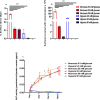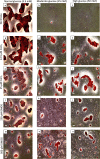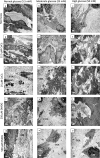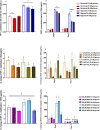Hypoxia mimetics restore bone biomineralisation in hyperglycaemic environments
- PMID: 35977987
- PMCID: PMC9385857
- DOI: 10.1038/s41598-022-18067-1
Hypoxia mimetics restore bone biomineralisation in hyperglycaemic environments
Abstract
Diabetic patients have an increased risk of fracture and an increased occurrence of impaired fracture healing. Diabetic and hyperglycaemic conditions have been shown to impair the cellular response to hypoxia, via an inhibited hypoxia inducible factor (HIF)-1α pathway. We investigated, using an in vitro hyperglycaemia bone tissue engineering model (and a multidisciplinary bone characterisation approach), the differing effects of glucose levels, hypoxia and chemicals known to stabilise HIF-1α (CoCl2 and DMOG) on bone formation. Hypoxia (1% O2) inhibited bone nodule formation and resulted in discrete biomineralisation as opposed to the mineralised extracellular collagen fibres found in normoxia (20% O2). Unlike hypoxia, the use of hypoxia mimetics did not prevent nodule formation in normal glucose level. Hyperglycaemic conditions (25 mM and 50 mM glucose) inhibited biomineralisation. Interestingly, both hypoxia mimetics (CoCl2 and DMOG) partly restored hyperglycaemia inhibited bone nodule formation. These results highlight the difference in osteoblast responses between hypoxia mimetics and actual hypoxia and suggests a role of HIF-1α stabilisation in bone biomineralisation that extends that of promoting neovascularisation, or other system effects associated with hypoxia and bone regeneration in vivo. This study demonstrates that targeting the HIF pathway may represent a promising strategy for bone regeneration in diabetic patients.
© 2022. The Author(s).
Conflict of interest statement
The authors declare no competing interests.
Figures







Similar articles
-
Dimethyloxalylglycine prevents bone loss in ovariectomized C57BL/6J mice through enhanced angiogenesis and osteogenesis.PLoS One. 2014 Nov 13;9(11):e112744. doi: 10.1371/journal.pone.0112744. eCollection 2014. PLoS One. 2014. PMID: 25394221 Free PMC article.
-
Repair of Critical-Sized Mandible Defects in Aged Rat Using Hypoxia Preconditioned BMSCs with Up-regulation of Hif-1α.Int J Biol Sci. 2018 Mar 11;14(4):449-460. doi: 10.7150/ijbs.24158. eCollection 2018. Int J Biol Sci. 2018. PMID: 29725266 Free PMC article.
-
Low level laser therapy promotes bone regeneration by coupling angiogenesis and osteogenesis.Stem Cell Res Ther. 2021 Aug 3;12(1):432. doi: 10.1186/s13287-021-02493-5. Stem Cell Res Ther. 2021. PMID: 34344474 Free PMC article.
-
Spatiotemporal correlation between HIF-1α and bone regeneration.FASEB J. 2022 Oct;36(10):e22520. doi: 10.1096/fj.202200329RR. FASEB J. 2022. PMID: 36065633 Review.
-
The Role of HIF-1α in Bone Regeneration: A New Direction and Challenge in Bone Tissue Engineering.Int J Mol Sci. 2023 Apr 28;24(9):8029. doi: 10.3390/ijms24098029. Int J Mol Sci. 2023. PMID: 37175732 Free PMC article. Review.
Cited by
-
Effect of Mesenchymal Stem Cells Overexpressing BMP-9 Primed with Hypoxia on BMP Targets, Osteoblast Differentiation and Bone Repair.Biology (Basel). 2023 Aug 19;12(8):1147. doi: 10.3390/biology12081147. Biology (Basel). 2023. PMID: 37627031 Free PMC article.
-
Bidirectional modulation of glycolysis using a multifunctional nanocomposite hydrogel promotes bone fracture healing in type 2 diabetes mellitus.Bioact Mater. 2025 Apr 8;50:152-170. doi: 10.1016/j.bioactmat.2025.03.020. eCollection 2025 Aug. Bioact Mater. 2025. PMID: 40256330 Free PMC article.
-
Amino Acid Metabolism in Bone Metastatic Disease.Curr Osteoporos Rep. 2023 Aug;21(4):344-353. doi: 10.1007/s11914-023-00797-4. Epub 2023 Jun 6. Curr Osteoporos Rep. 2023. PMID: 37277592 Review.
References
Publication types
MeSH terms
Substances
LinkOut - more resources
Full Text Sources
Medical

